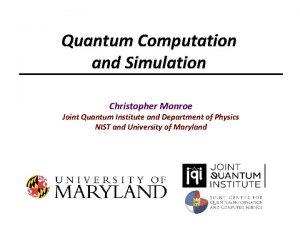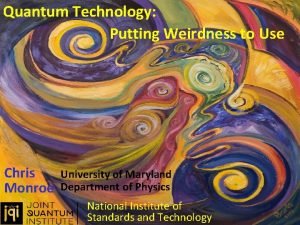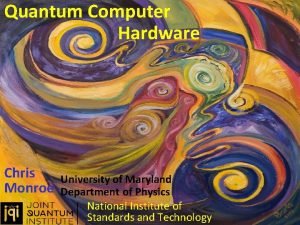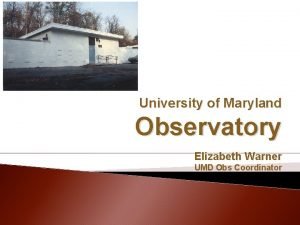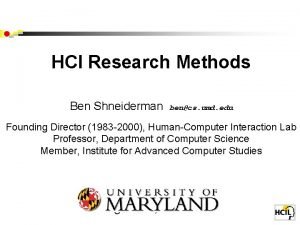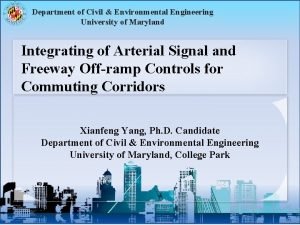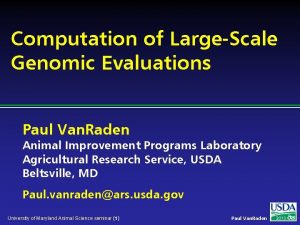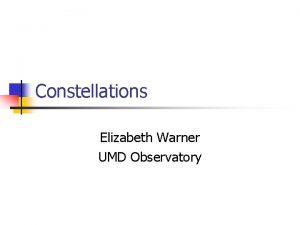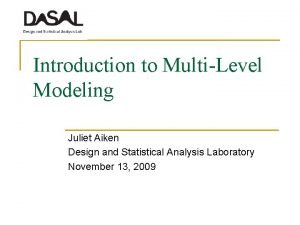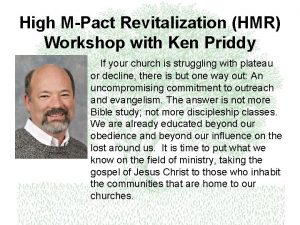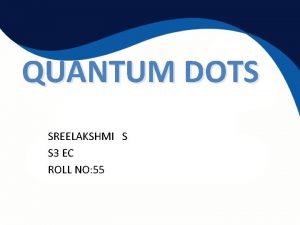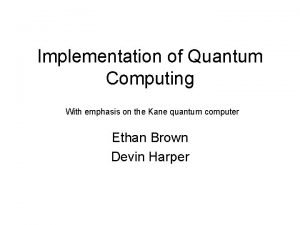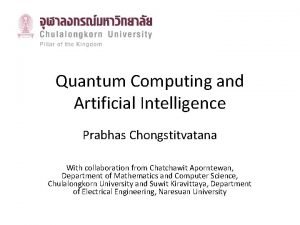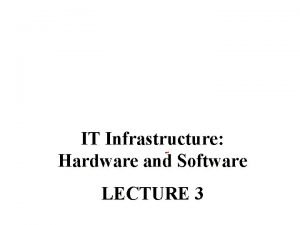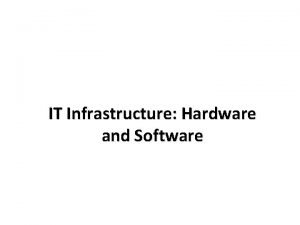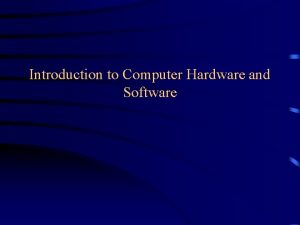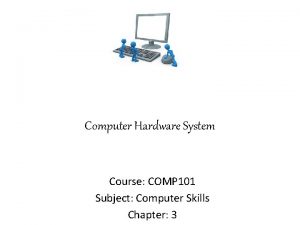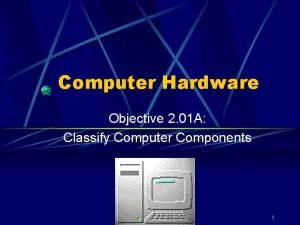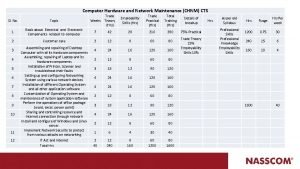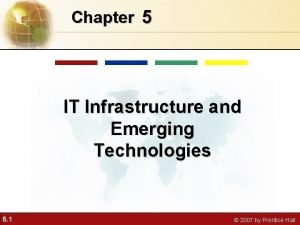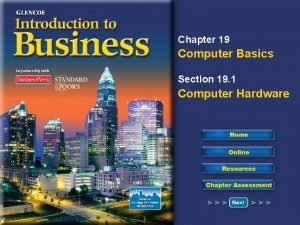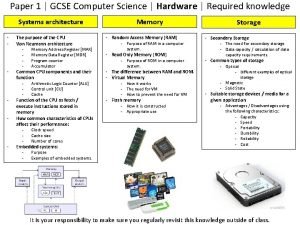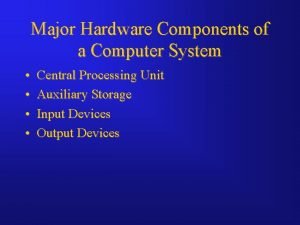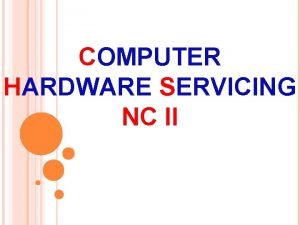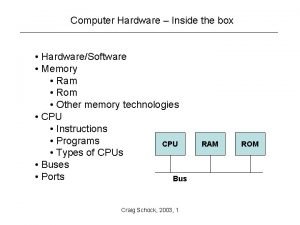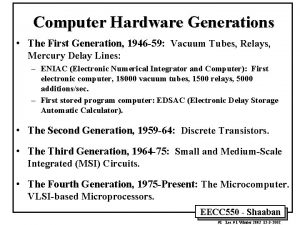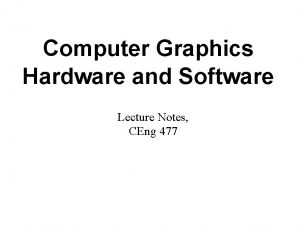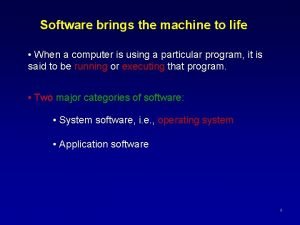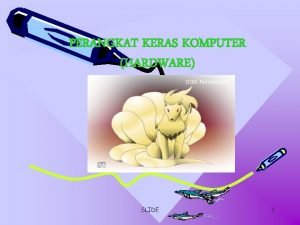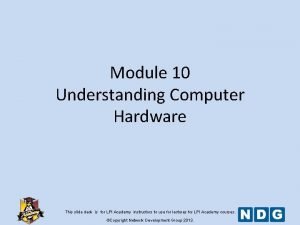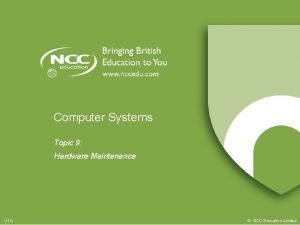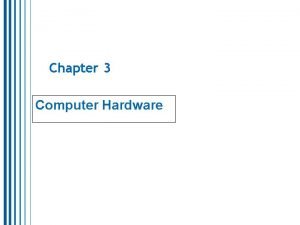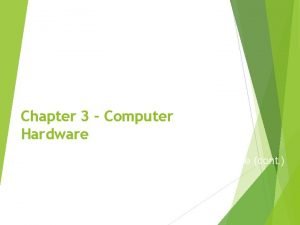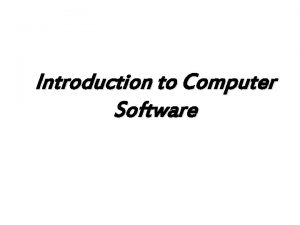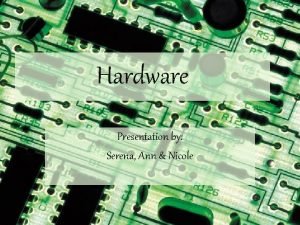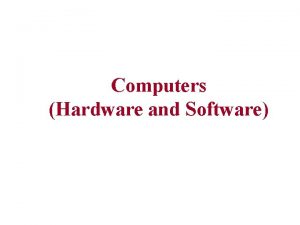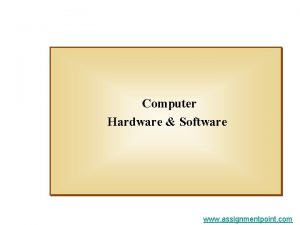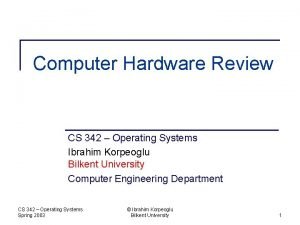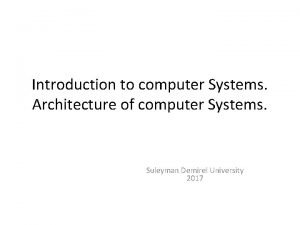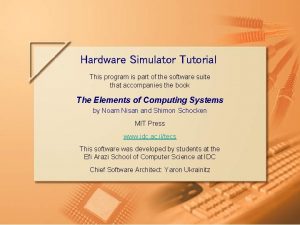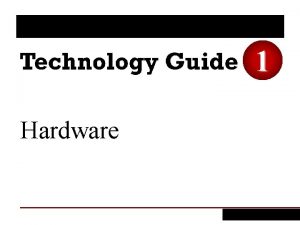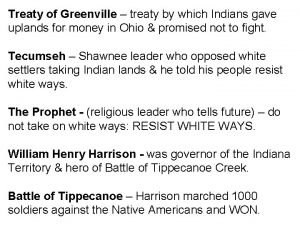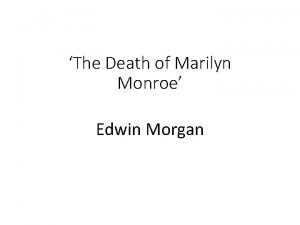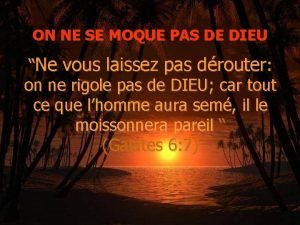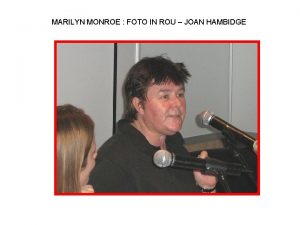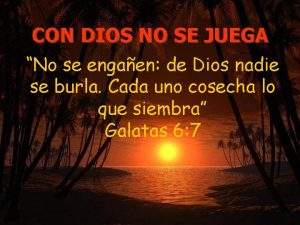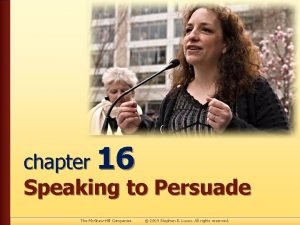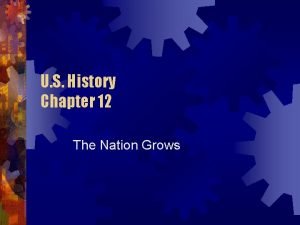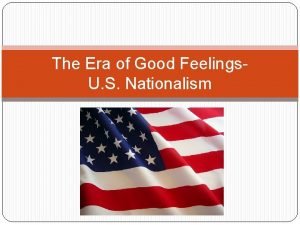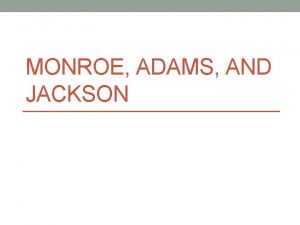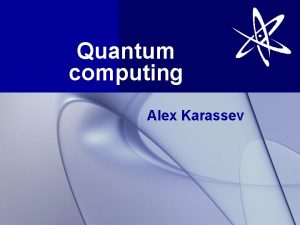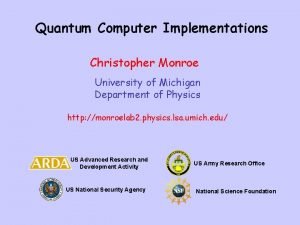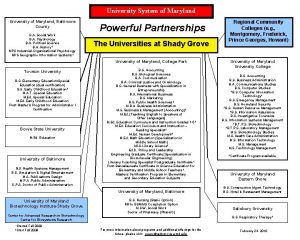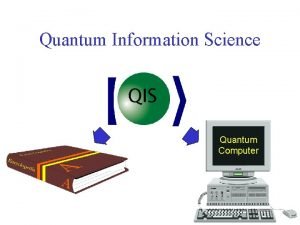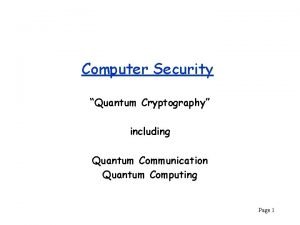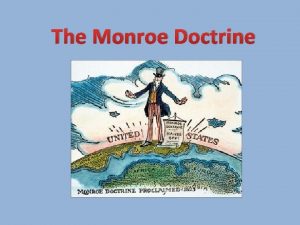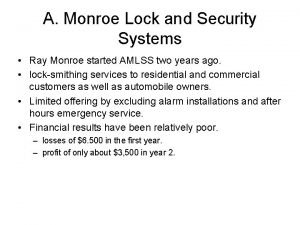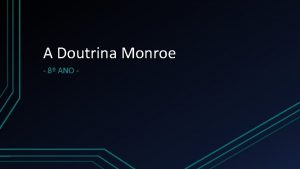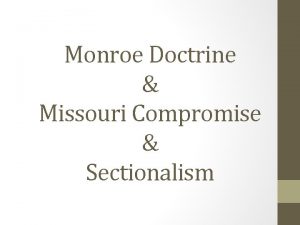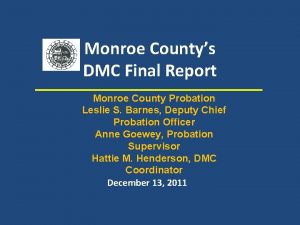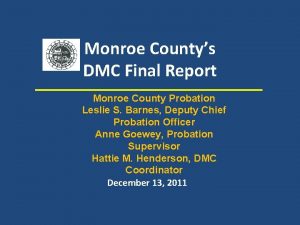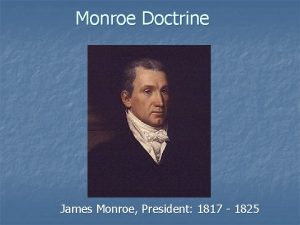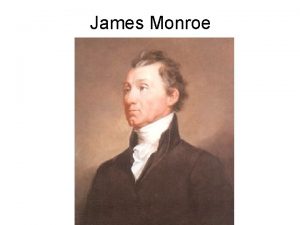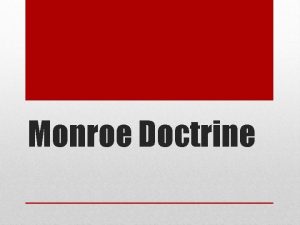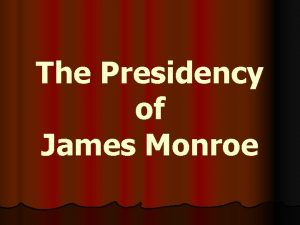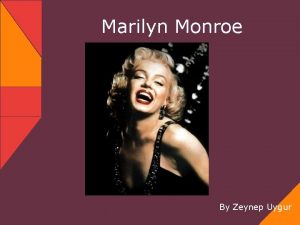Quantum Computer Hardware Chris Monroe University of Maryland






























































- Slides: 62

Quantum Computer Hardware Chris Monroe University of Maryland Department of Physics National Institute of Standards and Technology

Quantum Mechanics and Computing molecular-sized transistors 2025 atom-sized transistors 2040 “There's Plenty of Room at the Bottom” (1959) Richard Feynman “When we get to the very, very small world – say circuits of seven atoms – we have a lot of new things that would happen that represent completely new opportunities for design. Atoms on a small scale behave like nothing on a large scale, for they satisfy the laws of quantum mechanics…”

A new science for the 21 st Century Quantum Mechanics 20 th Century Information 0 1 1 0 0 0 1 1… Theory 21 st Century Quantum Information Science

Computer Science and Information Theory Charles Babbage (1791 -1871) mechanical difference engine Alan Turing (1912 -1954) universal computing machines Claude Shannon (1916 -2001) quantify information: the bit

ENIAC (1946)

The first solid-state transistor (Bardeen, Brattain & Shockley, 1947)

The classical NAND Gate A B out 0 0 1 1 1 0 V 0 out A B 32 -level NAND-based flash memory

The Golden Rules of Quantum Mechanics Rule #2: Rule #1 holds as long as you don’t look! probability or

GOOD NEWS… quantum parallel processing on 2 N inputs Example: N=3 qubits = a 0 |000 + a 1|001 + a 2 |010 + a 3 |011 a 4 |100 + a 5|101 + a 6 |110 + a 7 |111 f(x) N=300 qubits: more information than particles in the universe! …BAD NEWS… Measurement gives random result e. g. , |101 f(x)

…GOOD NEWS! quantum interference depends on all inputs

…GOOD NEWS! quantum interference quantum logic gates depends on all inputs quantum |0 + |1 NOT gate: |1 - |0 quantum |0 |0 XOR gate: |0 |1 |1 |0 |1 |1 |1 |0 e. g. , (|0 + |1 ) |0 |0 + |1 |1 superposition entanglement

Quantum State: |0 |0 + |1 |1 John Bell (1964) Any possible “completion” to quantum mechanics will violate local realism just the same

Citations to John Bell’s 1964 paper J. Bell, "On the Einstein Podolsky Rosen Paradox, " Physics 1, 195 (1964) 800 700 600 500 400 300 200 100 0 1970 1980 1990 2000 2010 499. 999999958532 49. 999958532 4. 9999958532 1970 1980 1990 2000 2010

Moore’s Law of Publishing # articles mentioning “Quantum Information” or “Quantum Computing” Nature Science Phys. Rev. Lett. Phys. Rev. 3000 2500 2000 Quantum Computers and Computing 1500 Institute of Computer Science Russian Academy of Science 1000 ISSN 1607 -9817 500 0 1995 2000 Shor’s Quantum Factoring Algorithm 2005 2010

(Classical) Error-correction Shannon (1948) Redundant encoding to protect against (rare) errors t c te ed ro p un potential error: bit flip 0/1 1/0 d te o pr e ct potential error: bit flip p(error) = p 000/111 010/101 etc. . 000/111 take majority better off whenever p < 1/2

Quantum error-correction Shor (1995) Steane (1996) Decoherence 5 -qubit code corrects all 1 -qubit errors to first order

N=1 N=1028


Trapped Atomic Ions Aarhus Amherst Basel Berkeley Bonn Citadel Clemson Denison Duke Erlangen ETH-Zurich Freiburg Georgia Tech Griffith Hannover Honeywell Indiana Innsbruck Lincoln Labs Lockheed Maryland/JQI Mainz MIT Munich NIST-Boulder Northwestern NPL-Teddington Osaka Oxford Paris Pretoria PTB-Braunschweig Saarbrucken Sandia Siegen Simon Fraser Singapore Sussex Sydney Tokyo Tsinghua-Beijing UCLA Washington-Seattle Weizmann Williams Yb+ crystal ~5 mm


171 Yb+ 2 S 1/2 | = |1, 0 | = |0, 0 hyperfine qubit w. HF/2 p = 12 642 812 118 + 311 B 2 Hz (600 Hz/G @ 1 G)

171 Yb+ qubit detection g/2 p = 20 MHz 2 P 2. 1 GHz 1/2 | z 0 369 nm 2 S Probability 1 0 5 10 15 20 # photons collected in 800 ms | | w. HF/2 p = 12 642 812 118 + 311 B 2 Hz (600 Hz/G @ 1 G) 25

171 Yb+ qubit detection g/2 p = 20 MHz 2 P 2. 1 GHz 1/2 >99% detection efficiency | z 0 369 nm 2 S Probability 1 0 5 | z 10 15 20 # photons collected in 500 ms | | w. HF/2 p = 12 642 812 118 + 311 B 2 Hz (600 Hz/G @ 1 G) 25

171 Yb+ 2 P 2 P qubit manipulation g/2 p = 20 MHz 3/2 D = 33 THz 1/2 355 nm (10 psec @ 100 MHz) 2 S 1/2 | | w. HF/2 p = 12 642 812 118 + 311 B 2 Hz (600 Hz/G @ 1 G)

Combination of coherence and perfect measurement : increment t t prepare ↓ measure P(↑) (bright or dark) laser beams : Prob(↑|↓) 1 0. 8 averaged data 0. 6 0. 4 0. 2 0 . 0 50 100 150 200 t (ms) 250 300 350 400

Entangling Trapped Ion Qubits r “dipole-dipole coupling” ~5 mm d d ~ 10 nm ed ~ 500 Debye for full entanglement Cirac and Zoller (1995) Mølmer & Sørensen (1999)

Programmable Quantum Computer… in the lab High NA objective vid Indi ms ea ual B al Glob m Bea 355 nm Raman beams Dk • • 5 -segment linear Paul trap High NA objective (0. 37) Tightly focused Raman beams 32 ch AOM and PMT for indiv. addressing/detection 355 nm pulsed laser Harris Corp 32 channel AOM 2μm pixels Diffractive optic (х10)

Quantum Fourier Transform (QFT) output amplitudes input amplitudes QFT circuit (n=5 qubits) controlled phase gate

Controlled-Phase Gate Controlled phase gate ± phase of Ising coupling

Quantum Fourier Transform (QFT) state preparation e. g. state with period 8 = results 7 15 23 31

Physics: global spin-dependent force F = F 0|↑ ↑| - F 0|↓ ↓|

Physics: global spin-dependent force | | ADD: Independent spin flips ↑ ↓ ↑ ↓ ↑↓↑ ↓↑ ↓ ↑ ↓ ↑↓ ↑↓↑ ↓ ↑ ↓ ↑ F = F 0|↑ ↑| - F 0|↓ ↓| B

Adiabatic Quantum Simulation from S. Lloyd, Science 319, 1209 (2008) Transverse Ising model Initialization: spins along x Detection: measure spins along z Time (<10 msec)

Antiferromagnetic Néel order of N=10 spins All in state 2600 runs, =1. 12 All in state AFM ground state order 222 events 219 events 441 events out of 2600 = 17% Prob of any state at random =2 x (1/210) = 0. 2%

First Excited States (Pop. ~2% each)

Second Excited States (Pop. ~1% each)

AFM order of N=14 spins (16, 384 configurations)

N=22 spins a = 0. 6 initial state at t=0 state measured at J 0 t = 36 B. Neyenhuis et al. , in preparation (2015)

Medium scale vision (>100 atomic spins) a (C. O. M. ) b (stretch) c (Egyptian) -15 -10 -5 d 2 a b a b+c 2 b, a+c a+b c-a b-a a 2 b, a+c d a+b c 2 a b c-a c axial modes only 20 am carrier be 40 ng oli b+c 60 d (stretch-2) co Fluorescence counts Mode competition – example: axial modes, N = 4 ions 0 5 Raman Detuning d. R (MHz) 10 Kielpinski, Monroe, Wineland, Nature 417, 709 (2002) 15 mode amplitudes

Univ. of Maryland Boulder

Mapping qubits from atoms to photons Given photon is collected 2 P 1/2 171 Yb+ R success probability B 2 S | 1/2 |

Doubling down: remote link through photons Upon coincidence detection! l/4 50/50 BS state of the art: l/4 optical fiber 171 Yb+ ion 171 Yb+ Simon & Irvine, PRL 91, 110405 (2003) L. -M. Duan, et. al. , QIC 4, 165 (2004) Y. L. Lim, et al. , PRL 95, 030505 (2005) D. Moehring et al. , Nature 449, 68 (2007) ion D. Hucul, et al. , Nature Phys. 11, 37 (2015)

tom a e l Sing re he atom e l g Sin here

Quantum teleportation of a single atom unknown qubit uploaded to atom #1 | + | qubit transfered to atom #2 | & | S. Olmschenk et al. , Science 323, 486 (2009).

we need more time. . and more qubits. .

Large scale modular Architecture (103 - 106 atomic spins? ) 0. 001 Hz before ~10 Hz now ~1 k. Hz soon CM et al. , Phys. Rev. A 89, 022317 (2014) D. Hucul, et al. , Nature Phys. 11, 37 (2015)


1947: first transistor 2000: integrated circuit single module N ion trap modules 2015: qubit collection Large scale quantum network?

Implementation of Quantum Hardware • • control & configurability trapped ions Verification? Ca nn ot quantum materials by design complex optimization “big quantum data” quantum computing m od el superconductors molecules NV Q-dots neutral atoms # particles

Leading Quantum Computer Hardware Candidates Trapped Atomic Ions individual atoms lasers photon Atomic qubits connected through laser forces on motion or photons Superconducting Circuits Superconducting qubit: right or left current Others: still exploratory FEATURES & STATE-OF-ART • very long (>>1 sec) memory • 5 -20 qubits demonstrated • atomic qubits all identical • connections reconfigurable Investments: IARPA GTRI Sandia FEATURES & STATE-OF-ART • connected with wires • fast gates • 5 -10 qubits demonstrated • printable circuits and VLSI LARGE Investments: CHALLENGES • lasers & optics • high vacuum • 4 K cryogenics • engineering needed Lockheed UK Gov’t CHALLENGES • short (10 -6 sec) memory • 0. 05 K cryogenics • all qubits different • not reconfigurable Google/UCSB IBM Lincoln Labs Intel/Delft • NV-Diamond • Semiconductor quantum dots • Atoms in optical lattices

D-Wave: superconducting circuits venture capital funding great advertising but is it quantum?


N=1 N=1028


Trapped Ion Quantum Information www. iontrap. umd. edu Grad Students Res. Scientists Jonathan Mizrahi David Campos Kai Hudek Clay Crocker Marko Cetina Shantanu Debnath Caroline Figgatt David Hucul ( UCLA) Volkan Inlek Kevn Landsman Aaron Lee Kale Johnson Harvey Kaplan Antonis Kyprianidis Lexi Parsagian Chris Rickerd Crystal Senko ( Harvard) Ksenia Sosnova Jake Smith Ken Wright Undergrads Eric Birckelbaw Kate Collins Micah Hernandez Postdocs Paul Hess Marty Lichtman Norbert Linke Brian Neyenhuis ( Lockheed) Guido Pagano Phil Richerme ( Indiana) Grahame Vittorini ( Honeywell) Jiehang Zhang Collaborators Luming Duan (Michigan) Philip Hauke (Innsbruck) David Huse (Princeton) LPS/NSA Alexey Gorshkov (JQI/NIST) Alex Retzker (Hebrew U) ARO

Quantum Superposition From Taking the Quantum Leap, by Fred Alan Wolf

Quantum Superposition From Taking the Quantum Leap, by Fred Alan Wolf

Quantum Superposition From Taking the Quantum Leap, by Fred Alan Wolf

Quantum Entanglement “Spooky action-at-a-distance” (A. Einstein) From Taking the Quantum Leap, by Fred Alan Wolf

Quantum Entanglement “Spooky action-at-a-distance” (A. Einstein) From Taking the Quantum Leap, by Fred Alan Wolf

Quantum Entanglement “Spooky action-at-a-distance” (A. Einstein) From Taking the Quantum Leap, by Fred Alan Wolf

Quantum Entanglement “Spooky action-at-a-distance” (A. Einstein) From Taking the Quantum Leap, by Fred Alan Wolf
 Chris monroe ionq
Chris monroe ionq Chris monroe quantum
Chris monroe quantum 詹景裕
詹景裕 Chris monroe umd
Chris monroe umd Origin of quantum mechanics
Origin of quantum mechanics Quantum physics vs mechanics
Quantum physics vs mechanics External hardware
External hardware University of maryland observatory
University of maryland observatory University of maryland capital region health medical group
University of maryland capital region health medical group Hci umd
Hci umd Environmental engineering
Environmental engineering Paul raden
Paul raden University of maryland observatory
University of maryland observatory Inside loyola login
Inside loyola login Juliet aiken
Juliet aiken Medscope university of maryland
Medscope university of maryland Ecroll
Ecroll Kane quantum computer
Kane quantum computer Quantum computer
Quantum computer Quantum of computer network
Quantum of computer network Language tool
Language tool Computer hardware platforms in it infrastructure
Computer hardware platforms in it infrastructure Computer hardware platforms in it infrastructure
Computer hardware platforms in it infrastructure Computer hardware introduction
Computer hardware introduction Computer arithmetic: algorithms and hardware designs
Computer arithmetic: algorithms and hardware designs Computer hardware 101
Computer hardware 101 Computer hardware classification
Computer hardware classification Chnnm
Chnnm Emerging technology chapter 5
Emerging technology chapter 5 Graphic organizer of computer hardware
Graphic organizer of computer hardware Hardware gcse computer science
Hardware gcse computer science What are the major hardware components of a computer
What are the major hardware components of a computer Computer hardware servicing nc2
Computer hardware servicing nc2 Access memory
Access memory First generation computer hardware
First generation computer hardware Computer graphics hardware and software
Computer graphics hardware and software Software brings computer hardware to life
Software brings computer hardware to life Computer hardware skills
Computer hardware skills Computer hardware slides
Computer hardware slides Computer graphics introduction ppt
Computer graphics introduction ppt Types of computer hardware maintenance
Types of computer hardware maintenance Computer hardware history
Computer hardware history 3 components of computer
3 components of computer Computer virus is a hardware or software
Computer virus is a hardware or software Hardware presentation
Hardware presentation A computer system consists of both hardware and software
A computer system consists of both hardware and software Mail @ assignmentpoint.com
Mail @ assignmentpoint.com Computer hardware review in operating system
Computer hardware review in operating system Diagram of system unit
Diagram of system unit Computer hardware simulator
Computer hardware simulator Major hardware components of a computer system
Major hardware components of a computer system Who is this guy
Who is this guy The death of marilyn monroe poem edwin morgan
The death of marilyn monroe poem edwin morgan Billy graham marilyn monroe
Billy graham marilyn monroe Marilyn monroe foto in rou gedig
Marilyn monroe foto in rou gedig Marilyn monroe taille 44
Marilyn monroe taille 44 Con dios no se juega
Con dios no se juega New imperialism definition ap world history
New imperialism definition ap world history Mc-graw hill
Mc-graw hill Tala monroe
Tala monroe Aeration monroe county
Aeration monroe county Monroe doctrine political cartoon meaning
Monroe doctrine political cartoon meaning Monroe doctrine
Monroe doctrine
